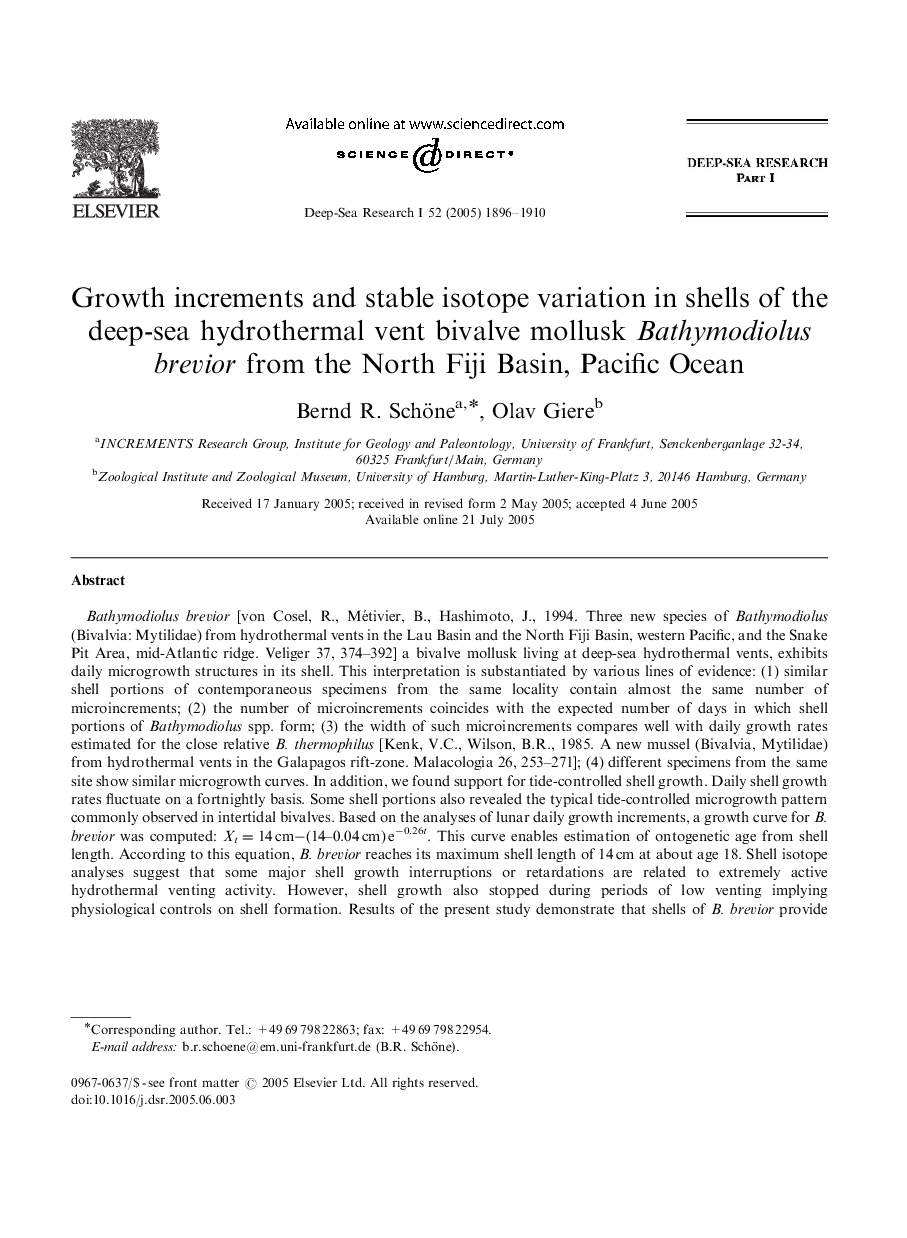| کد مقاله | کد نشریه | سال انتشار | مقاله انگلیسی | نسخه تمام متن |
|---|---|---|---|---|
| 9479570 | 1326111 | 2005 | 15 صفحه PDF | دانلود رایگان |
عنوان انگلیسی مقاله ISI
Growth increments and stable isotope variation in shells of the deep-sea hydrothermal vent bivalve mollusk Bathymodiolus brevior from the North Fiji Basin, Pacific Ocean
دانلود مقاله + سفارش ترجمه
دانلود مقاله ISI انگلیسی
رایگان برای ایرانیان
کلمات کلیدی
موضوعات مرتبط
مهندسی و علوم پایه
علوم زمین و سیارات
زمین شناسی
پیش نمایش صفحه اول مقاله

چکیده انگلیسی
Bathymodiolus brevior [von Cosel, R., Métivier, B., Hashimoto, J., 1994. Three new species of Bathymodiolus (Bivalvia: Mytilidae) from hydrothermal vents in the Lau Basin and the North Fiji Basin, western Pacific, and the Snake Pit Area, mid-Atlantic ridge. Veliger 37, 374-392] a bivalve mollusk living at deep-sea hydrothermal vents, exhibits daily microgrowth structures in its shell. This interpretation is substantiated by various lines of evidence: (1) similar shell portions of contemporaneous specimens from the same locality contain almost the same number of microincrements; (2) the number of microincrements coincides with the expected number of days in which shell portions of Bathymodiolus spp. form; (3) the width of such microincrements compares well with daily growth rates estimated for the close relative B. thermophilus [Kenk, V.C., Wilson, B.R., 1985. A new mussel (Bivalvia, Mytilidae) from hydrothermal vents in the Galapagos rift-zone. Malacologia 26, 253-271]; (4) different specimens from the same site show similar microgrowth curves. In addition, we found support for tide-controlled shell growth. Daily shell growth rates fluctuate on a fortnightly basis. Some shell portions also revealed the typical tide-controlled microgrowth pattern commonly observed in intertidal bivalves. Based on the analyses of lunar daily growth increments, a growth curve for B. brevior was computed: Xt=14Â cmâ(14-0.04Â cm)Â eâ0.26t. This curve enables estimation of ontogenetic age from shell length. According to this equation, B. brevior reaches its maximum shell length of 14Â cm at about age 18. Shell isotope analyses suggest that some major shell growth interruptions or retardations are related to extremely active hydrothermal venting activity. However, shell growth also stopped during periods of low venting implying physiological controls on shell formation. Results of the present study demonstrate that shells of B. brevior provide calendars and environmental data loggers that can complement or partly substitute for long-term observations of venting systems.
ناشر
Database: Elsevier - ScienceDirect (ساینس دایرکت)
Journal: Deep Sea Research Part I: Oceanographic Research Papers - Volume 52, Issue 10, October 2005, Pages 1896-1910
Journal: Deep Sea Research Part I: Oceanographic Research Papers - Volume 52, Issue 10, October 2005, Pages 1896-1910
نویسندگان
Bernd R. Schöne, Olav Giere,